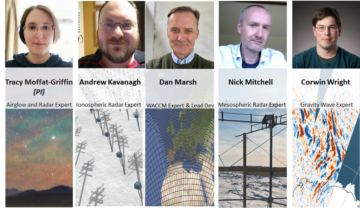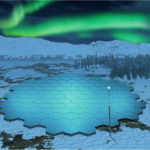In order to accurately predict impacts of space weather and climate variability on the whole atmosphere we need an accurate representation of the whole atmosphere.
The mesosphere (~50-95 km altitude) is the most poorly understood region of the atmosphere, it is the critical boundary between two domains (the climate domain and the space weather domain) and this presents a problem when trying to model and predict conditions in the whole atmosphere. Currently the level of prediction in the mesosphere is no better than climatology. Historically there have been few observations of this region to help us characterise it. However, in the past decade or so the number of observations has increased markedly, including multiple middle atmosphere observing satellite missions. We plan to take advantage of this golden age of middle atmosphere observations and together with one of the world most sophisticated whole atmosphere models to quantify the variability and drivers of the mesosphere.
The mesosphere influences, and is influenced by, in-situ and external effects such as atmospheric waves and tides (upward) and space weather effects (downward). The mesosphere is strongly coupled to the lower edge of the ionosphere, as well as the other atmospheric regions, so changes in one part can impact on others. In order to make progress in modelling the whole atmosphere as a coupled system we need to have a sound scientific understanding of the drivers of variability. For climate models we have a good level of predictability for ~2 weeks and one the ~decades scale. However, critically we cannot do this in the mesosphere yet. We aim to focus our efforts on understanding variability on the sub-seasonal to decadal variations in the mesosphere as a pathway to improving model predictions.
We will use the highly instrumented region of Scandinavia, in conjunction with satellite data, to determine the variability of the mesosphere/lower ionosphere and its drivers over a sub seasonal to decadal scale. We will be among the first to use a new, ~£50 million, high-resolution instrument (EISCAT 3D). This will be the world’s most sophisticated ionospheric radar which will allow unprecedented small scale measurements of variations in the middle atmosphere. In conjunction with special high-resolution whole atmosphere model simulations, we will determine the drivers and variability of this atmospheric region and provide a first step along the road of improving predictability of the mesosphere at sub-seasonal to decadal timescales.
The primary objective of MesoS2D is:
To quantify the physical drivers of mesosphere variability at all timescales, opening a
pathway to improved predictability of weather and climate processes in the Earth system.
Our project builds from regional observationally-driven studies to whole-atmospheric dynamical-
science advances via four closely-linked sub-objectives. We will:
- Identify and quantify the key physical drivers of observed mesosphere variability, as driven
by mechanisms above, below and in-situ.
- Characterize MLTI variability at timescales from hours to decades over Scandinavia, an
exceptionally well-instrumented testbed region where we will benefit directly from NERC’s
recent investment in the state-of-the-art EISCAT-3D (E3D) radar.
- Based on these quantified drivers, develop and implement the improvements needed to
advance mesosphere predictability in the WACCM global atmospheric model, and provide
the insight needed to apply this to other models.
- Use our observations and new model capabilities to quantify how the mesosphere couples
to and preconditions dynamical variability in the ionosphere and underlying atmosphere,
with impacts for GNSS, radio communications, and weather prediction.
By the end of this three-year project, MesoS2D will have produced three key outputs:
- An integrated physical understanding of the dynamics and chemistry of the mesosphere,
facilitating the next generation of whole-atmosphere weather and climate modelling.
- Quantitative constraints on coupling between the neutral and charged atmosphere,
providing key constraints for enhanced GNSS accuracy and space weather forecasting.
- Explanations for the drivers of mesosphere variability at both long and short-timescales,
improving model predictive skill in a very poorly-understood part of the Earth system.
Investigator team:

13 January, 2022
A new project to improve scientists understanding of the impact of space weather and climate change on the atmosphere starts this month (January 2022). A team from British Antarctic Survey, …
This page will be populated once the project starts.

